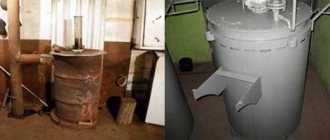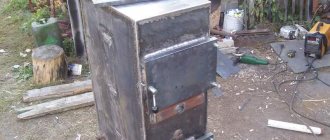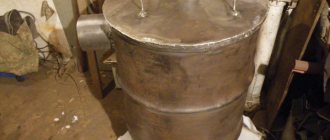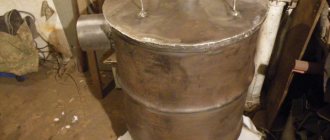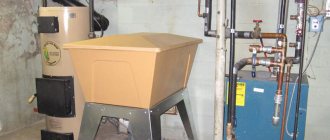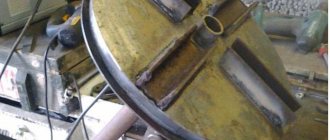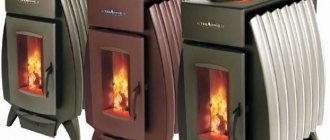Sawdust is an excellent material for heating houses and greenhouses.
They are made of wood, which means that when used correctly, they are only slightly inferior in heat capacity to firewood.
You can get them cheaply , and in some cases even for free .
Next we will tell you about different methods of heating different rooms with sawdust:
- houses;
- makeshift;
- greenhouses
We will also consider in detail all types of heating stoves and long-burning boilers that can use sawdust as fuel.
Features of boiler operation
The most reliable and innovative types of boilers using solid fuel elements include automatic water heating systems. Their design includes:
- fuel bunker;
- gas generator;
- boiler for heating the coolant (combustion chamber and heat exchange chamber);
- equipment operation monitoring system.
The body consists of the following elements:
- fuel chamber;
- chimney;
- ash pan;
- heat spreader;
- coil;
- blower;
- a set of sensors for monitoring temperature and pressure.
The automatic control system works as follows:
- If necessary, add wood chips to the boiler.
- Controls the oxygen supply taking into account the remaining fuel.
- Regulates temperature changes.
- Extinguishes fires in an emergency.
Features of boilers and furnaces:
- The body and structural elements are made of steel sheets coated on the outside with a heat insulator.
- The inside of the oven is lined with fireclay bricks, which increases the heat level when heated.
- The doors are made airtight, with the addition of concrete.
- With the help of ventilation, primary and secondary oxygen, which is necessary for the combustion process, enters the firebox.
- The drum-type heat exchanger is protected from limescale by circulating water.
Due to the complex heat exchange system, the efficiency of such boilers is quite high. Wood waste up to 4 cm in size is used for kindling.
Thermal radiation without loss
The above article and video discuss this issue in detail. It becomes clear that lining the boiler with bricks close to its walls will create an excess of thermal radiation in the boiler firebox, which, together with the exhaust hot gases, will rush into the chimney. That’s what we need, and a damper installed in the chimney after the register will allow us to well regulate the operation of the boiler and the heating of the coolant.
You can line the boiler and register with basalt wool, and make a casing of tin on top.
Pros and cons of a sawdust heating system
To get the most complete picture of the chips, which can act as fuel for modern heating systems, it is very useful to consider the advantages and disadvantages inherent in the method in question.
Advantages
- Among all the advantages that heating with wood waste has, the main one should be low heating costs. Consumers will be able to achieve maximum savings provided that there are wood processing enterprises operating in their area of residence. After all, in this case they will be able to buy sawdust at very low prices.
- When using wood as fuel, it will take a minimum of time to heat the water. In addition, these wastes allow you to obtain the maximum amount of thermal energy. Choosing briquetted chips is even more preferable, since in this case you can provide the house with even more heat.
- When operating a boiler that uses natural raw materials for operation, there is no harm to the environment, since during the combustion of wood waste a very small amount of toxins is released into the atmosphere.
- An additional advantage is that a sawdust-fired boiler is available to everyone. In addition to this, to install this device, there is no need to obtain the same large number of permits that are required when connecting the boiler to the gas main.
Flaws
For all their advantages, installations using sawdust also have a number of disadvantages. These include difficulties arising with fuel storage. Although pressed wood chips and shavings are compact in size, you still need to ensure there is a room large enough to hold a supply of this fuel.
It should be borne in mind that the process of burning wood produces a lot of ash and soot. Many people know that ash can serve as a fertilizer. However, you cannot benefit from soot. For this reason, an operation such as chimney cleaning should be carried out on a regular basis.
Advantages and disadvantages of boilers of this type
Like any equipment, solid fuel boilers have certain advantages and disadvantages. Almost all the shortcomings of such equipment occur due to the fact that they use wood chips. First of all, wood chips have low free-flowing properties, which makes their transportation more problematic. Sawdust chips have high humidity, and therefore combustion rates are significantly lower compared to wood and coal.
Heating boilers using wood, wood chips and sawdust have many more positive qualities.
- The cost of fuel is low, because it is waste and was previously simply thrown away.
- Full automation of the operation of solid fuel boilers makes it possible to use them even when there are no people in the house.
- Modern automation tools make it possible not only to fine-tune the equipment, but also to automatically monitor its serviceability, thereby preventing the occurrence of malfunctions of certain boiler components.
- All wood fuel is completely clean from an environmental point of view, due to which such devices do not pose any harm to the environment.
(votes: 1, average: 4.00 out of 5)
Cost of popular wood pellets
Price table for the most common types of pellets.
| Variety "gray" | 1st grade | |
| Dimensions | Ø8mm | Ø8mm |
| Packing | 30kg bag | bag 25kg |
| Compound | fur tree, pine tree | spruce |
| Number of bags per pallet | 33 bags + 10kg | 40 bags |
| Humidity | 8% | 7,8% |
| Ash content | 0,7% | 0,5% |
| Calorie content | 4605 kcal/kg | 4854 kcal/kg |
| Calorific value | 4.4 kWh/kg | 4.4 kWh/kg |
| Density | 1.2 g/cm3 | 1.2 g/cm3 |
| Price | 7700 rub. | 8500 rub. |
Fuel requirements
The efficiency of boilers directly depends on the moisture content of the sawdust. The use of dry shavings and sawdust from carpentry as fuel does not cause problems. The bulk of sawdust, as noted, is waste from roundwood sawing shops.
Industrial waste from sawing round timber on band sawmills is small (up to 0.3 mm) sawdust with a moisture content of up to 80%. Even with constant forced air supply to the firebox, such sawdust burns very slowly, since it takes time to dry it. An even greater problem when burning is damp, long-stored sawdust, compacted into a damp, dusty mass.
Such fuel should be burned in a certain mode:
- Dry and wet fuel should be supplied to the combustion chamber in a ratio of 3:1.
- The supply of raw fuel can only be started when the boiler reaches full power after ignition.
- Constantly force air into the combustion chamber using a fan.
Required video
In this video, the owner of a private house tells how to increase the combustion of sawdust in the stove:
Inexpensive or free sawdust is a good substitute for firewood or coal as a heating fuel. However, you should not burn them in direct combustion furnaces and boilers , due to the fact that they are intended for other types of fuel.
For such heat supply, they make sawdust burners with their own hands or order them from a specialist. The costs of purchasing or manufacturing such radiators will be justified within five to ten years if you have the opportunity to get sawdust for free or practically free.
Design features
The specificity of fuel such as sawdust is that its particles are tightly pressed against each other and prevent the penetration of oxygen necessary to maintain the combustion process (those who have had to deal with coal know that for the same reason large stones burn much better than coal crushed into dust).
They are tightly packed into a cylindrical combustion chamber, and a conical rod is inserted in the central part.
During combustion, the rod is removed and a vertical channel is formed - an adit, through which air moves. Sawdust burns layer by layer from the middle.
And this combustion occurs very slowly, in smoldering mode.
There are several modifications of such heating devices:
- One or two holes for the chimney.
- One or two walls.
- Remote or built-in ash drawer.
Note. The stove is made from a two-hundred-liter barrel and can be heated with one load of sawdust for 10 hours.
Water boiler
Heating of the room can be done using water or air. If there is a water supply in the house, you can assemble a system with your own hands with circulating water between the heating boiler and radiators or a “warm floor” system.
In the body of the boiler itself for water heating, the pipes are in water, which will be heated by the action of hot air passing inside them. This system is similar to a gas water heater
Rice. 2 Water double-circuit heating boiler system
The circulation of water through the system begins even before it enters the boiler.
For optimal system operation you need:
- controller for water level in the tank;
- overflow so that the water does not exceed the permissible level;
- a pump that lifts water from the radiator circuit;
- lower outlet for water intended for floor heating.
It is difficult to make such a sawdust boiler with your own hands, but a house equipped with such equipment will be very comfortable to live in all year round.
Video material
Independent processing of wood waste using a screw press of your own production will be rational only if you have free time and affordable raw materials. Therefore, carefully weigh the pros and cons of such a decision before embarking on the process of creating equipment.
The best known manufacturers and models: characteristics and prices
When choosing a boiler for sawdust and wood chips, in addition to technical characteristics, you should pay attention to the country and brand of the manufacturer. Northern European countries have learned to squeeze the highest economic performance out of fuel
To this end, they have been working for a long time on improving automation specifically for private homes, and given their desire for comfort and environmental requirements, you should pay attention to the products of the companies Hargassner, Froling, ETA. Of course, if the budget allows.
Russian-made boilers, especially if the developer is a well-known European brand on the market, may well be competitive. At a significantly lower price, they are quite capable of providing both the reliability and comfort of a private home. In addition, they are unpretentious in raw materials and maintenance, and the automation even in European solid fuel boilers is often from China.
Specialized
These are boilers designed primarily for the use of bulk solid fuels.
Pyrolysis Master BIO-15
One of the best sawdust boilers for heating a private home. It also works on wood chips, peat, and sunflower husks. With the use of replaceable burners it can burn straw. Thanks to a five-pass heat exchanger, it has a high efficiency of 91% and has a hopper capacity of 200 liters. The only drawback is its considerable dimensions.
Cost: 185,000-240,000 rubles.
FACI FSS 115
It is produced in Russia, but the developer is Italy. This is an automatic industrial boiler for burning wood waste. Power adjustable within 25-115 kW, efficiency 92%. As additional options, it is equipped with auto-ignition, burner self-cleaning, and remote control. Hopper capacity is 810 liters, fuel is supplied by two augers. Can burn any biomass with a fraction not exceeding 40 mm. The 115 kW model has a huge weight of 1150 kg, which increases the flooring and transport requirements.
Cost: 450,000-477,000 rubles.
Universal models
Boilers using any solid fuel: all types of coal, peat, firewood, wood waste, seed husks, briquettes with varying efficiency, but structurally designed for long-term combustion. They are much cheaper than specialized ones, but also much less effective and practical when working with sawdust.
Tis Pro DR
Excellent inexpensive universal boiler. Furnace steel 5 mm thick is used as a heat exchanger, which is a very good indicator in terms of reliability and durability. It also features a huge firebox; depending on the power, the volume of the combustion chamber can be 80-116 liters. Does not use fan pressure and is non-volatile. Available in 17, 22 and 27 kW versions, efficiency reaches 82%.
Owners often note that the design of the grate is extremely practical: they are separate, cast iron (reliable and easily replaceable). No deficiencies were found due to operating practices.
Cost: 58,500-72,000 rubles.
PEREKO KSP Duo
High-tech Polish universal TT boiler of the highest price category. The innovative burner allows high-quality combustion of fine-grained fuel from eco-peas to oats as efficiently as possible. A water-filled grate in the combustion chamber makes it possible to burn wood and its waste.
Equipped with automation controlled by the ST-480 controller, which, in addition to controlling the central heating and hot water pumps, the boost fan, can also control the operation of the mixing valve and take into account signals from room and street temperature sensors. Available in power variations: 12, 18, 26, 36, 52 kW. In addition to the price, the disadvantages are large dimensions, weight and low permissible operating pressure - only 1.5 bar.
Cost: 283,000-498,000 rubles.
LIEPSNELĖ L20U
Universal Lithuanian long-burning shaft-type boiler with a power of 20 kW. The fuel is coal, pressed briquettes from coal, peat, wood waste, sawdust and other raw materials. The efficiency reaches 91%, but this is only when heating with low-ash coal; when using sawdust and wood chips, the efficiency will be lower. The heat exchanger is cast iron, in a steel casing. The boiler is known for its reliability, quality of alloys used and assembly. Even when using sawdust and wood chips, the burning time of one load can be achieved in 2-3 days.
The only drawbacks, as in the previous case, are the low operating pressure of 1.5 bar and heavy weight.
Cost: 110,000-125,000 rubles.
Pros and cons of the technique
The main advantages of using burning sawdust and wood chips as an energy source for the heating system are:
- High efficiency of heating the coolant (usually water, although antifreeze can also be used in a water system), with the help of which the house is kept warm, and sometimes also provides hot water supply.
- Low cost of raw materials. A system based on the use of a sawdust boiler will be especially advantageous if there are one or more woodworking enterprises (for example, furniture factories or sawmills) near the heated premises.
- Ecological purity of sawdust as fuel. Their combustion practically does not release toxic substances into the atmosphere, unlike a number of liquid and gaseous energy carriers.
- Easy to operate and maintain. Almost everyone can use equipment that runs on sawdust and wood chips. And its installation does not require permission from regulatory authorities, as when connecting a gas appliance.
Naturally, such a system also has disadvantages. Among them, it is worth noting the difficulty of storing material that is highly flammable.
This problem is partially eliminated by pressing the fuel, however, sawdust still needs to be stored in a fairly spacious room.
Another disadvantage is the need for periodic cleaning of chimneys, which is due to the large amount of soot and ash generated during operation.
In general, the positive effect that the method of heating rooms with long-term burning of sawdust gives is much greater compared to some of its disadvantages. This means that such systems have a right to exist. And, moreover, over time they can supplant traditional heating options.
The principle of operation of a sawdust-wood boiler
Pyrolysis combi boilers using wood and sawdust have an internal structure and a modified design that ensures maximum heat transfer and efficiency when burning fuel. The operating principle of heating equipment is as follows:
- During the combustion of solid fuel, a large amount of carbon dioxide is released. The CO produced is sent to the afterburner. During transportation, an air-gas mixture is formed, burned at high temperatures. To maintain the required temperature conditions, the afterburning chamber is made of fireclay bricks.
The heated gases are not immediately discharged into the chimney, but are directed into a broken chimney channel located inside the boiler, surrounded by a coolant liquid medium. The pyrolysis process and changes in the boiler design increased the efficiency from 70% (in standard models) to 92% (in gas generating equipment).
Modulation operating mode – long-burning solid fuel boilers for firewood and sawdust use sensitive automation connected to room thermostats. Depending on the heating needs of the room, performance varies from 30 to 100%.
The use of two types of fuel - you can independently choose as the main source of heat: firewood or sawdust. The second type of fuel will be used as a reserve. After the firewood has burned out and the coolant has begun to cool, the burning of sawdust or wood chips will start automatically.
Bifuel boilers use sawdust and firewood as fuel. Working on each of these types of fuel has its own characteristics.
Wood burning
Universal long-burning solid fuel boilers can operate on wood and sawdust. But, in the case of using firewood, the thermal efficiency of the equipment increases. This is explained simply. Firewood, when burned, releases the maximum amount of carbon dioxide, which is used to generate additional heat.
Wood burning has the following features:
- Fuel filling and ignition are carried out manually.
The intensity of air supply to the firebox is controlled using a damper either manually or automatically.
The autonomous operation of the boiler from one load varies, depending on the quality of the firewood and the model of the heating unit, from 6 to 24 hours.
If you compare the technical data of boilers using wood and sawdust, it is more profitable to burn with logs. The main disadvantage of using firewood is the need for constant maintenance of the hot water boiler. It is necessary to add fuel 2-3 times a day, clean out the ash and clean the combustion chamber. All work is done manually.
Burning sawdust
Sawdust combustion is carried out with maximum automation of the process. Combustion and fuel supply proceed as follows:
- Sawdust enters the combustion chamber via a screw transmission. The intensity of movement of the fuel conveyor is monitored by the boiler automation. In the event of an emergency, a signal is given to turn off the supply of sawdust. If necessary, a mechanized fuel storage facility is organized. After connecting the bunker, the boiler is able to operate throughout the entire heating season without stopping.
Electric ignition – sawdust is ignited using a plasma arc. An optical sensor is installed in the combustion chamber to monitor the presence of flame. When it fades, the sawdust is ignited again.
Sawdust is burned with artificial air injection. A stable flame is created, heating the coolant as quickly as possible.
Along with sawdust and firewood, in dual-fuel units it is allowed to use wood chips made from hard wood with a moisture content of no more than 20%.
How to make a long burning stove
To make a sawdust stove with your own hands, you can use a ready-made metal container: a barrel, a can, an empty gas cylinder or a pipe of a suitable diameter. To work you will need a welding machine, an angle grinder and skills to work with them.
A simple sawdust stove from a barrel
If you have a metal barrel at your disposal, then first of all you need to cut off the top from it. This should be done carefully, since in the future the part will be used for its intended purpose, but as a removable cover.
Next, a circle with a diameter slightly smaller than the parameters of the barrel is cut out of a metal sheet with a thickness of at least 3 mm. In the center of the circle, make a hole for a pipe with a diameter of 10 cm and carefully weld the resulting workpiece to the inner walls, departing 15-20 cm from the bottom.
Just below the welded sheet, a small window is cut out - a blower, to allow the oxygen necessary for combustion to enter the firebox. A hole for the chimney is cut out in the upper part of the cylinder; a pipe is welded to it to remove carbon monoxide from the firebox.
The chimney requires special attention - too powerful a draft will contribute to the rapid release of gases and reduce the thermal efficiency of the device. If the draft is weak, another problem may arise - life-threatening combustion products will begin to enter the room.
Experienced craftsmen recommend artificially lengthening the chimney pipe by running it around the perimeter of the room, or adapting the chimney for preparing hot water by including a boiler in the design. All this will help keep the house warm and get the most out of it.
The lid is made from a cut off top, welding the sides to it, or from a metal sheet
It is important to ensure the tightness of the structure, otherwise combustion will occur instead of smoldering. For the tightest possible connection, special heat-resistant seals for furnaces are used. For convenience, be sure to weld the handle
For convenience, be sure to weld the handle.
Rules for operating a homemade stove
For all its effectiveness, the homemade device works simply:
- A cone-shaped pipe is installed into the hole in the metal sheet - this is easier to remove at the right time.
- The container is filled with sawdust to the level of the chimney in small portions, carefully tamping each layer.
- The pipe is carefully removed, leaving a hole in the center for oxygen to enter the fuel and exhaust gases to exit.
- The stove is closed with a lid and the fuel is ignited from the ash side. To make kindling easier, you can pour some flammable liquid onto the metal partition before loading the sawdust.
- The smoldering process in a barrel with a volume of about 200 liters lasts at least 8 hours - during this time the stove lid cannot be opened and sawdust should not be added. A new load can be made only after the previous batch of fuel has completely burned.
How to improve the budget model
The simplest potbelly stove made from a barrel is suitable for a country house, garage or greenhouse. For a residential building, it is recommended to modernize the structure by increasing the heating area by constructing an additional smoke circuit.
The contour can be made external or internal. In the first case, you will need a similar mold of a larger diameter, and in the second you need to find a slightly smaller barrel or weld a suitable metal container.
The external contour is attractive by increasing the heat transfer area and maintaining the volume of the combustion chamber, while the internal contour is easier to operate. In both options, the chimney should be moved downwards.
It is better to make the cover from a thick steel sheet with a thickness of at least 5 mm and reinforce it at the edges, otherwise it will quickly deform from high temperature.
Making a potbelly stove
Long-burning potbelly stoves are good because they are made from any available materials - these are various barrels, old capacious cans, pieces of large-diameter pipes or simply sheet metal. We chose sheet steel as the starting material - it is a more convenient material to process. You can adapt a barrel for this, but doing work in its internal volume is not very convenient.
All sizes are presented rather as guidelines, a kind of averaged best option. You, in turn, can deviate from the dimensions of the parts to create a stove that satisfies your specific wishes.
The design of a long-burning furnace is quite clear from the drawing presented above. Here are its main components:
- Combustion chamber - wood burns in it with the formation of pyrolysis gas;
- Afterburner – combustion of pyrolysis products occurs in it;
- Doors of the combustion chamber and ash pan - they are purchased in the store, but you can make them yourself;
- Chimney - in most cases it is a pipe with a diameter of 100-150 mm.
You can deviate from the drawing in one direction or another. But remember that as the size decreases, the burning time decreases and the power of the long-burning stove decreases.
The lower the power, the smaller the heated area. Therefore, it is best to provide a small reserve.
To make a long-burning stove like a potbelly stove, we need sheet steel with a thickness of at least 3 mm - this will ensure a long service life of the heating equipment. If the steel is thin, it will begin to burn through - after a couple of seasons, holes will form in it
Therefore, special attention is paid to the thickness of the steel. The optimal thickness is 3-5 mm
For our example, we will take the classic scheme of a potbelly stove, modify it and get at our disposal an effective wood-burning stove for a home. At the initial stage, we prepare the side sheets - in our drawing they have dimensions of 450x450 mm. Next, we make the lower walls, front and rear walls - their dimensions are 200x450 mm. As a result, we should get a rectangular box. But don’t rush to weld it together - there is a lot of work ahead.
First you need to make a base - this is the bottom wall and two side ones. We weld them together, weld the grate at a height of 80 mm from the bottom. Now we need to prepare the front wall of the long-term heating oven - we weld both doors into it, and then weld it to our structure.
We prepare two metal sheets measuring 200x370 mm. We weld the first of them to the front and side walls at a height of 160 mm from the top. Next, we prepare the back wall - we weld small metal tubes into it, which should fit into the space between the two inner sheets that form the afterburning chamber - secondary air will be supplied through them. Then we weld the back wall and a second metal sheet at a height of 80 from the top (welded to the side and rear walls).
The damper is used to regulate air flow. It is this that improves the efficiency and quality of traction.
Our DIY long-burning stove is almost ready - all that remains is to figure out the top cover. We make a hole in it with a diameter of 100 mm and weld a piece of pipe for the future chimney. Now it remains to find out whether you need a hob or not - it is also welded into the top cover. At the last stage, we install the lid in place and weld it - the stove is ready, now it can be installed on a non-combustible base, attached to the chimney and started.
When starting the long-burning stove presented above, let it burn, then cover the ash pit so that the wood barely smolders and the generation of pyrolysis gas begins.
Another interesting long-burning pyrolysis furnace is shown in the following figure. It is made from a barrel or a piece of large diameter pipe and is equipped with a suitable lid. In the lower part, at a distance of 80-100 mm from the bottom, a metal disk with a hole in the middle is welded. A door is welded between the disk and the bottom, on the side wall. The resulting space forms our firebox. We weld a chimney with a diameter of 70-100 mm in the upper part.
In terms of low cost of use, such a stove is a real gift, since there is no shortage of sawdust in a private home.
The resulting long-burning furnace receives heat by burning pyrolysis gases generated when heating sawdust. The sawdust itself is poured into the main volume, and to prevent it from spilling into the firebox, it is compacted using a wooden cone. When the stove starts, a fire is lit in the firebox, the cone is removed - after a while the unit will begin to produce heat.
How to assemble it yourself?
The basis for the manufacture of a sawdust stove is a 200 liter whole steel barrel without rust.
A propane tank, a piece of steel pipe, or a large fire extinguisher will work well. In this part, the main indicator is the wall thickness; the service life of the entire product depends on it. Other materials you will need:
- Material for the legs (with a round base), which can be used as pipe scraps, pieces of reinforcement, channel, etc.
- Two steel circles with a barrel diameter and a wall thickness of 5 mm.
- Ready-made or self-made door.
- The pipe is 15 cm longer than the barrel, and 100 mm. in diameter.
- Pipe, 5 m long and 100 mm in diameter. for the chimney.
You will need the following tools:
- Gas cutter or grinder.
- Welding machine.
- Hammer
- Measuring tools (tape measure, level).
- Before making a product with your own hands, carefully study the drawing, after which they begin assembly, consisting of the following steps:
- Preparing the fuel tank. The upper part of the barrel is cut off after preliminary precise marking, so as not to spoil the workpiece. Also, according to the markings, the bottom is cut off, which is not thrown away, but will be used as a lid.
- Making the bottom of the furnace from a steel sheet, which is cut to the diameter of the firebox. A hole is made in its center along the diameter of the supply pipe.
- Manufacturing a pipe supplying oxygen to the combustion zone. To do this, you will need a workpiece longer than the fuel tank, and equal in diameter to the hole in the firebox. In it, longitudinal lines are cut with a grinder or perforations in an amount of more than 50 pieces are made with a drill.
- A perforated pipe is inserted into the middle of the bottom and welded, after which a cover is cut out with a hole in the center, adjusted to the diameter of the pipe (the cover is placed on it). An additional hole is also made near the edge to control draft and air access, on which a movable damper is placed. For convenience, the cover is equipped with arches for ease of maintenance.
- Installation of a chimney from a pipe with a diameter of 10 cm and a pipe connected to it with a clamp. The pipe is carefully connected by welding to the side outlet at the top of the firebox and a pipe is put on it.
- The boiler is installed on supports, which are made of metal profiles welded to the furnace body, as indicated in the drawings.
All parts of a stove operating on sawdust become very hot, which is why the boiler used for heating the room should not be installed next to flammable materials and surfaces, and should not be left unattended. It is prohibited to service the device without protective gloves and in violation of fire safety regulations.
